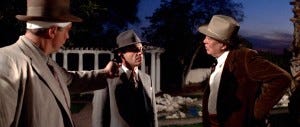Chinatown | Apocalypse
The revelation of allegations against Adam Donaghey were a repulsive and shocking reminder of how rife abuse remains in American cinema, especially after #metoo. But we should not be surprised. Stories of abuse have always been central to Hollywood, from mythmaking legends like Fatty Arbuckle to Peggy Entwhistle throwing he…
Keep reading with a 7-day free trial
Subscribe to Cinema Year Zero to keep reading this post and get 7 days of free access to the full post archives.





